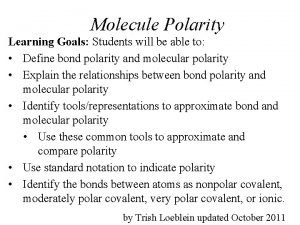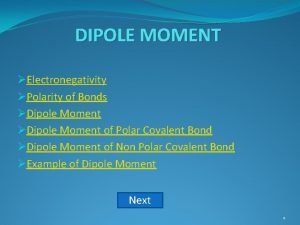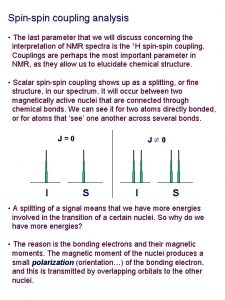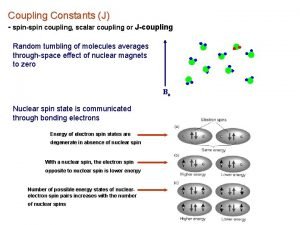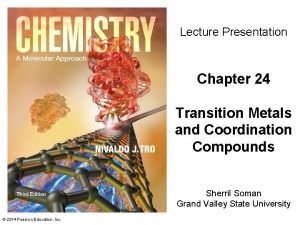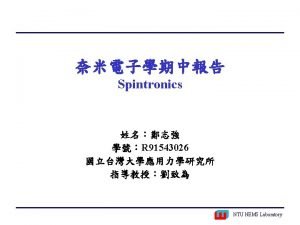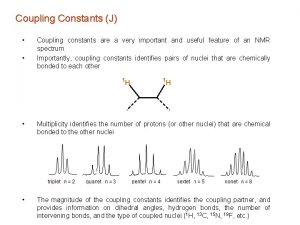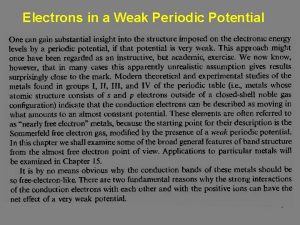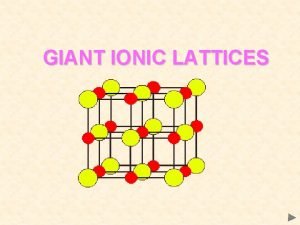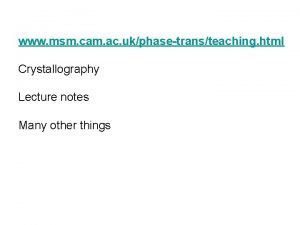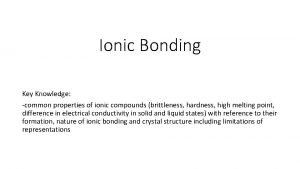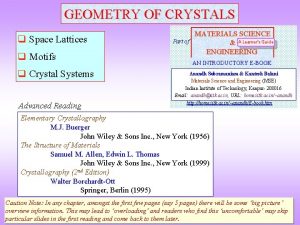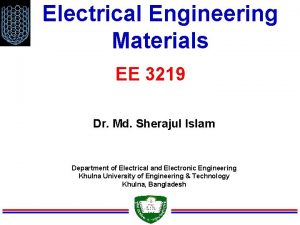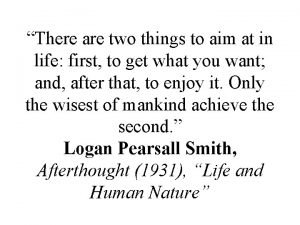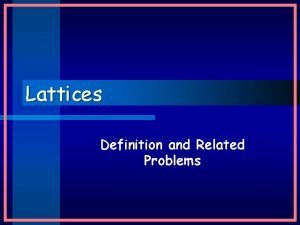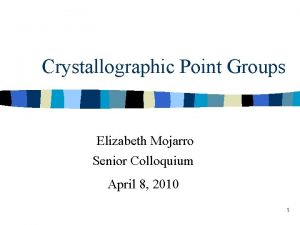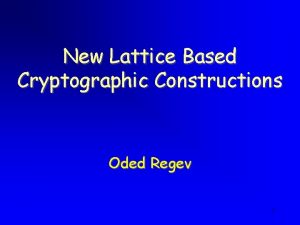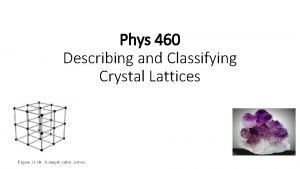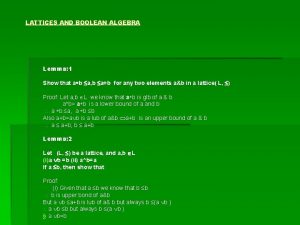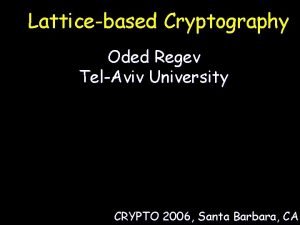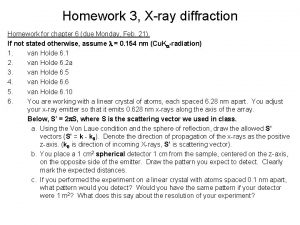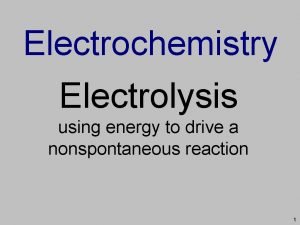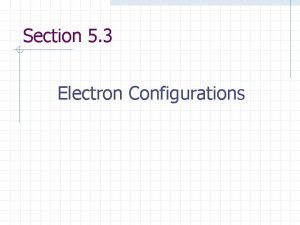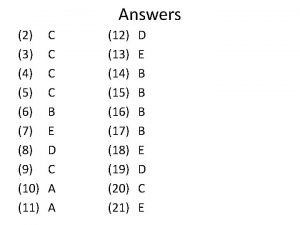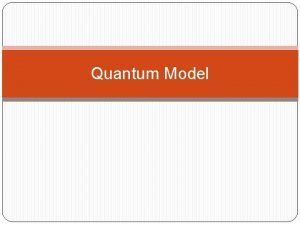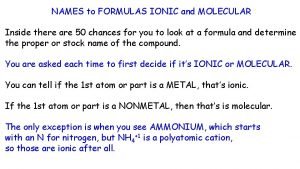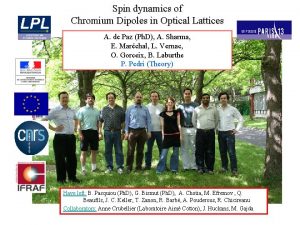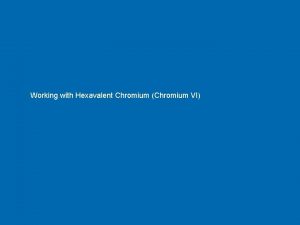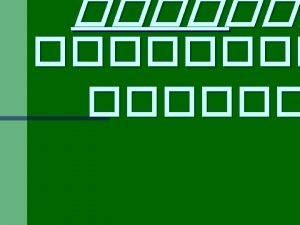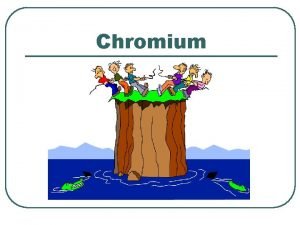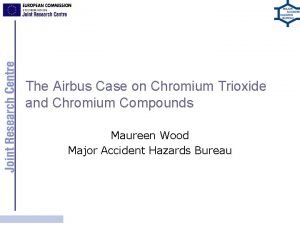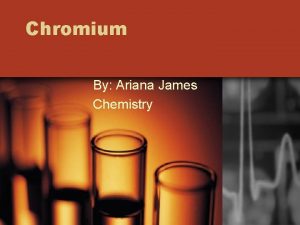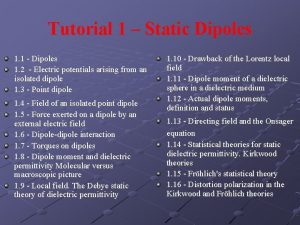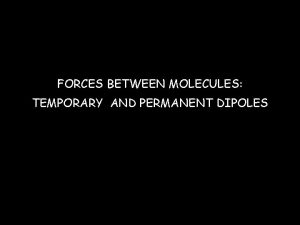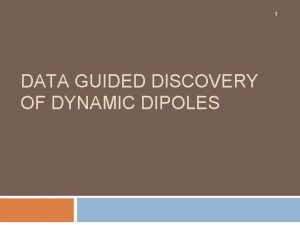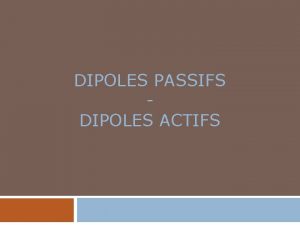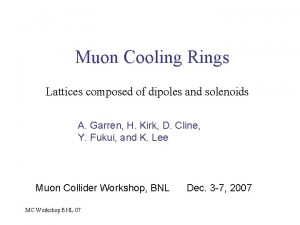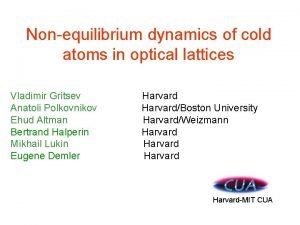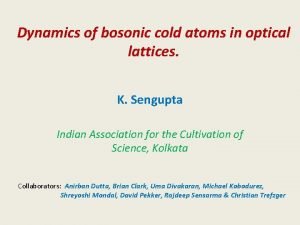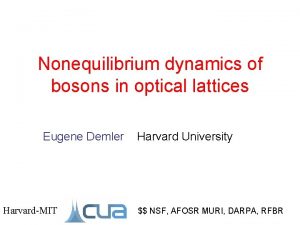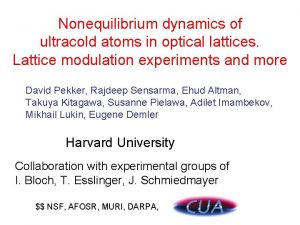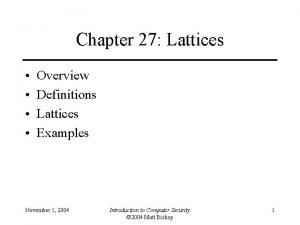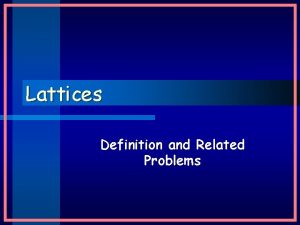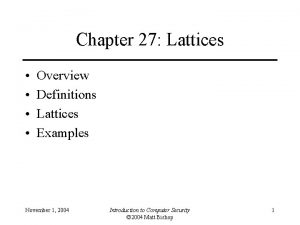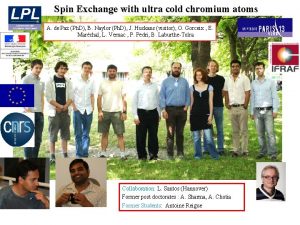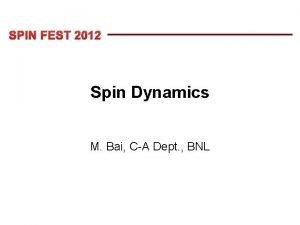Spin dynamics of Chromium Dipoles in Optical Lattices




























- Slides: 28

Spin dynamics of Chromium Dipoles in Optical Lattices A. de Paz (Ph. D), A. Sharma, E. Maréchal, L. Vernac, O. Gorceix, B. Laburthe P. Pedri (Theory) Have left: B. Pasquiou (Ph. D), G. Bismut (Ph. D), A. Chotia, M. Efremov , Q. Beaufils, J. C. Keller, T. Zanon, R. Barbé, A. Pouderous, R. Chicireanu Collaborators: Anne Crubellier (Laboratoire Aimé Cotton), J. Huckans, M. Gajda

Chromium : an artificially large spin (S=3): (magnetic) dipole-dipole interactions Long range Anisotropic R Van-der-Waals (contact) interactions Short range Isotropic

Relative strength of dipole-dipole and Van-der-Waals interactions Spherical BEC collapses Stuttgart: Tune contact interactions using Feshbach resonances (Nature. 448, 672 (2007)) Anisotropic explosion pattern reveals dipolar coupling. Stuttgart: d-wave collapse, PRL 101, 080401 (2008) See also Er PRL, 108, 210401 (2012) See also Dy, PRL, 107, 190401 (2012) and Dy Fermi sea PRL, 108, 215301 (2012) … and heteronuclear molecules… BEC stable despite attractive part of dipole-dipole interactions Cr: Small (but interesting) effects observed – at the % level : - Striction – Stuttgart, PRL 95, 150406 (2005) - Collective excitations - Villetaneuse, PRL 105, 040404 (2010) - Anisotropic speed of sound, Villetaneuse, PRL 109, 155302 (2012) R

Polarized ( « scalar » ) BEC Hydrodynamics Collective excitations, sound, superfluidity Multicomponent ( « spinor » ) BEC Magnetism Phases, spin textures… Chromium (S=3): involve dipole-dipole interactions Long-ranged Anisotropic R Hydrodynamics: non-local mean-field Magnetism: Atoms are magnets Interactions couple spin and orbital degrees of freedom

Introduction to spinor physics Chapman, Sengstock… Exchange energy Coherent spin oscillation Quantum effects! Klempt Stamper-Kurn Domains, spin textures, spin waves, topological states Stamper-Kurn, Chapman, Sengstock, Shin… Quantum phase transitions Stamper-Kurn, Lett, Gerbier

Main ingredients for spinor physics S=1, 2, … Spin-dependent contact interactions Spin exchange Main new features with Cr S=3 7 Zeeman states 4 scattering lengths New structures Strong spin-dependent contact interactions Purely linear Zeeman effect 1 0 -1 And Dipole-dipole interactions Quadratic Zeeman effect

Dipolar interactions introduce magnetization-changing collisions without Dipole-dipole interactions R 1 0 -1 3 2 1 0 -1 -2 -3 with

Dipolar relaxation, rotation, and magnetic field Angular momentum conservation 3 0 -3 -2 1 2 -1 Rotate the BEC ? Spontaneous creation of vortices ? Einstein-de-Haas effect Ueda, PRL 96, 080405 (2006) Santos PRL 96, 190404 (2006) Gajda, PRL 99, 130401 (2007) B. Sun and L. You, PRL 99, 150402 (2007) Important to control magnetic field

S=3 Spinor physics with free magnetization 1 Spinor physics of a Bose gas with free magnetization (bulk) 2 (Quantum) magnetism in optical lattices Technical challenges : Good control of magnetic field needed (down to 100 m. G) Active feedback with fluxgate sensors Low atom number – 10 000 atoms in 7 Zeeman states

Spin temperature equilibriates with mechanical degrees of freedom At low magnetic field: spin thermally activated 3 2 1 0 -1 -2 -3 -3 -2 -1 0 1 2 3 We measure spin-temperature by fitting the m. S population (separated by Stern-Gerlach technique) Related to Demagnetization Cooling expts, Pfau, Nature Physics 2, 765 (2006)

Spontaneous magnetization due to BEC T>Tc T<Tc -3 -2 -1 0 1 2 3 Thermal population in Zeeman excited states -3 -2 -1 0 1 2 3 a bi-modal spin distribution BEC only in m. S=-3 (lowest energy state) Cloud spontaneously polarizes ! A non-interacting BEC is ferromagnetic New magnetism, differs from solid-state PRL 108, 045307 (2012)

Below a critical magnetic field: the BEC ceases to be ferromagnetic ! B=100 µG B=900 µG -Magnetization remains small even when the condensate fraction approaches 1 !! Observation of a depolarized condensate !! Necessarily an interaction effect PRL 108, 045307 (2012)

-1 3 2 1 0 -1 -2 -3 Cr spinor properties at low field 3 -2 -3 Large magnetic field : ferromagnetic -3 -2 -1 0 1 2 Low magnetic field : polar/cyclic Santos PRL 96, 190404 (2006) -3 PRL 106, 255303 (2011) -2 Ho PRL. 96, 190405 (2006) Good agreement between field below which we see demagnetization and Bc

Magnetic field Open questions about equilibrium state Santos and Pfau PRL 96, 190404 (2006) Diener and Ho PRL. 96, 190405 (2006) Phases set by contact interactions, magnetization dynamics set by dipole-dipole interactions Demler et al. , PRL 97, 180412 (2006) Cyclic Polar !! Depolarized BEC likely in metastable state !! - Operate near B=0. Investigate absolute many-body ground-state -We do not (cannot ? ) reach those new ground state phases -Quench should induce vortices… -Role of thermal excitations ?

Magnetic phase diagram Quasi. Boltzmann distribution Measure Tc(B) and M(Tc, B) for different magnetic fields B Get Tc(M) Bi-modal spin distribution Phase diagram adapted from J. Phys. Soc. Jpn, 69, 12, 3864 (2000) See also PRA, 59, 1528 (1999)

0 Introduction to spinor physics 1 Spinor physics of a Bose gas with free magnetization 2 (Quantum) magnetism in opical lattices

Study quantum magnetism with dipolar gases ? Hubard model at half filling, Heisenberg model of magnetism (effective spin model) Dipole-dipole interactions between real spins Magnetization changing collisions

Magnetization dynamics resonance for a Mott state with two atoms per site (~15 m. G) 1 ce ca pti BE ep we 2 s Rf R 3 0 Pro du ce ep e f sw d o a Lo tti l la m=+3, wait time C m =-3 -3 -2 1 2 -1 detect m=-3 Dipolar resonance when released energy matches band excitation Mott state locally coupled to excited band ar. Xiv: 1212. 5469 (2012)

Direct manifestation of anisotropic interactions : Strong anisotropy of dipolar resonances Anisotropic lattice sites May produce vortices in each lattice site (Einstein-de-Haas effect) ar. Xiv: 1212. 5469 (2012) See also PRL 106, 015301 (2011)

From now on : stay away from dipolar magnetization dynamics resonances, Spin dynamics at constant magnetization (<15 m. G) Magnetization changing collisions Can be suppressed in optical lattices Differs from Heisenberg magnetism: Related research with polar molecules: A. Micheli et al. , Nature Phys. 2, 341 (2006). A. V. Gorshkov et al. , PRL, 107, 115301 (2011), See also D. Peter et al. , PRL. 109, 025303 (2012) And talk by A. Gorshkov…

Control the initial state by a tensor light-shift 0 -1 -3 -2 -1 0 1 2 A s- polarized laser Close to a J J transition (100 m. W 427. 8 nm) D=a m. S 2 3 -2 -3 Quadratic effect allows state preparation

Adiabatic state preparation in 3 D lattice t ec f f e ic at r d a qu t -3 -2 Initiate spin dynamics by removing quadratic effect ce i att l al c pti o d a Lo ect d qua ra eff tic vary time

Short times : fast oscillations due to spin-dependent contact interactions -1 -2 -3 G= ( 250 µs) (period 220 µs) PRELIMINARY Up to now unknown source of damping (sudden melting of Mott insulator ? ) (Gap is much smaller in state m. S=-2)

Long time-scale spin dynamics in lattice : intersite dipolar exchange Sign for intersite dipolar interaction (much slower than on-site dynamics) Magnetization is constant PRELIMINARY

Oscillations arise from interactions between doubled-occupied sites Effect of doublons ? PRELIMINARY Very slow spin dynamics for one particle per site: Intersite dipole-dipole coupling

Our current understanding: (Very) long time-scale dynamics due to inter-site dipolar exchange between singlons 1/e timescale = 25 ms Theoretical estimate : 2 atoms, 2 sites : exchange timescale = 50 ms Spin oscillations due to inter-site dipolar exchange between doublons Timescale = 4 ms Exact diagonalization 2 pairs, 2 sites Faster coupling because larger effecive spin

Conclusions Bulk Magnetism: spinor physics with free magnetization New spinor phases at extremely low magnetic fields Lattice Magnetism: Magnetization dynamics is resonant Intersite dipolar spin-exchange

A. de Paz, A. Chotia, A. Sharma B. Pasquiou, G. Bismut, B. Laburthe-Tolra, E. Maréchal, L. Vernac, P. Pedri, M. Efremov, O. Gorceix Arijit Sharma Aurélie De Paz Amodsen Chotia
 Relationship between bond dipoles and molecular dipoles
Relationship between bond dipoles and molecular dipoles Dipole meaning in chemistry
Dipole meaning in chemistry Spin spin coupling
Spin spin coupling J coupling constant
J coupling constant Low spin and high spin complex
Low spin and high spin complex Spin down
Spin down J coupling constant
J coupling constant Electrons in periodic lattices
Electrons in periodic lattices Giant ionic structures
Giant ionic structures Bravais lattices
Bravais lattices Which is not a common property of ionic compounds?
Which is not a common property of ionic compounds? 7 crystal systems and 14 bravais lattices
7 crystal systems and 14 bravais lattices 14 bravais lattices
14 bravais lattices 7 crystal systems and 14 bravais lattices
7 crystal systems and 14 bravais lattices Lattices definition
Lattices definition Glide reflection
Glide reflection Oded regev
Oded regev Bravais lattice
Bravais lattice Isotonic property of lattice
Isotonic property of lattice Oded regev lattices
Oded regev lattices Braggs law definition
Braggs law definition Copper orbital diagram
Copper orbital diagram What mass of chromium could be deposited by electrolysis
What mass of chromium could be deposited by electrolysis Aufbau principle
Aufbau principle Chromium etchant 1020
Chromium etchant 1020 Triphosphorus pentasulfide
Triphosphorus pentasulfide Bac 5625
Bac 5625 Quantum numbers for chromium
Quantum numbers for chromium Ionic
Ionic
